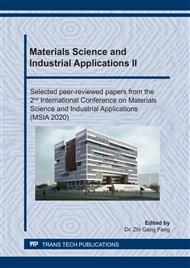[1]
W. T. Liu, Nanoparticles and their biological and environmental applications, J. Biosci. Bioeng. 102 (2006) 1-7.
Google Scholar
[2]
H. Y. Han, Z.H. Sheng, J.G. Liang, Electrogenerated chemiluminescence from thiol-capped CdTe quantum dots and its sensing application in aqueous solution, Anal. Chim. Acta. 596 (2007) 73-78.
DOI: 10.1016/j.aca.2007.05.039
Google Scholar
[3]
S. Cavaliere-Jaricot, M. Darbandi, E. Kucur, T. Nann. Silica coated quantum dots: a new tool for electrochemical and optical glucose detection, Microchim Acta. 160 (2008) 375-383.
DOI: 10.1007/s00604-007-0795-y
Google Scholar
[4]
E. Golub, G. Pwlossof,R. Freeman, H. Zhang, I. Willner, Electrochemical, photo electrochemical, and surface Plasmon resonance detection of cocaine using supramolecular aptamer complexes and metallic or semiconductor nanoparticles, Anal. Chem. 81 (2009) 9291–9298.
DOI: 10.1021/ac901551q
Google Scholar
[5]
H. Bekir-Yildiz, R.Freeman, R. Gill, I. Willner.Electrochemical, photoelectrochemical and piezoelectric analysis of tyrosinase activity by functionalized nanoparticles. Anal. Chem. 801(2008)2811–2816.
DOI: 10.1021/ac702401v
Google Scholar
[6]
Z. Yue, W. Zhang, C. Wang, G. H. Liu, W. C. Niu, Photoinduced Electron Transfer between CdS Quantum Dots and Gold Electrodes. Acta. Phys-Chim. Sin. 27 (2011) 2814-2820.
Google Scholar
[7]
D.J. Norris, A.L. Efros, S.C. Erwin. Doped Nanocrystals. Science. 319 (2008)1776-1779.
DOI: 10.1126/science.1143802
Google Scholar
[8]
J.J. Zheng, S. Cao, F. M. Gao, G.D. Wei, Synthesis of Effective and Qualified Cu-doped ZnSe Quantum Dots and Their Optical Properties, J.Inorg. Mater. 28 (2013) 159-164.
DOI: 10.3724/sp.j.1077.2013.12184
Google Scholar
[9]
P. Wu, X. P. Yan, Doped quantum dots for chemo/ biosensing and bioimaging, Chem. Soc. Rev. 42(2013) 5489–5521.
DOI: 10.1039/c3cs60017c
Google Scholar
[10]
L. Espinal, S. Lsuib, J. F. Rusling, Electrochemical catalysis of styrene epoxidation with fifilms of MnO2 nanoparticles and H2 O2, J. Am. Chem. Soc.126(2004)7676–7682.
DOI: 10.1021/ja048940x
Google Scholar


